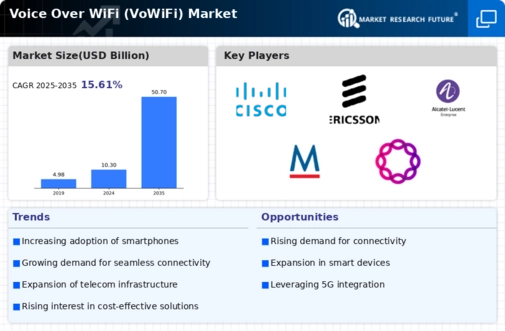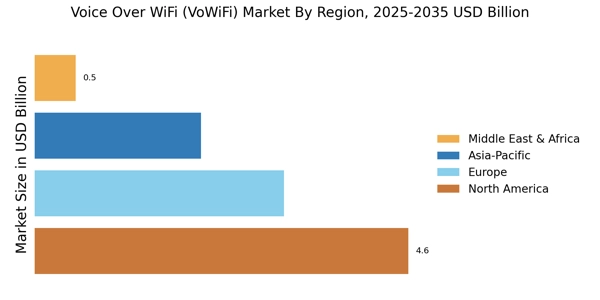Integration with IoT Devices
The integration of Voice Over WiFi Market (VoWiFi) technology with Internet of Things (IoT) devices is emerging as a significant driver for the VoWiFi Market. As smart homes and connected devices become more commonplace, the need for seamless communication between these devices and users is paramount. VoWiFi enables users to control IoT devices through voice commands, enhancing user experience and convenience. This trend is likely to accelerate as more households adopt smart technology. Furthermore, the compatibility of VoWiFi with various IoT platforms can lead to innovative applications, thereby expanding the market. The synergy between VoWiFi and IoT is expected to create new revenue streams for service providers, contributing to the overall growth of the VoWiFi Market.
Increased Smartphone Penetration
The proliferation of smartphones has been a pivotal driver for the Voice Over WiFi Market (VoWiFi) Market. As of October 2025, it is estimated that over 80% of the global population owns a smartphone, facilitating the adoption of VoWiFi services. This trend indicates a growing consumer preference for mobile communication solutions that leverage WiFi networks. The convenience of making calls over WiFi, especially in areas with poor cellular coverage, enhances user experience and satisfaction. Consequently, telecom operators are increasingly investing in VoWiFi technology to meet the demands of a tech-savvy consumer base. This shift not only boosts the VoWiFi Market but also encourages competition among service providers to offer enhanced features and services.
Cost Efficiency for Service Providers
Cost efficiency remains a crucial factor driving the Voice Over WiFi Market (VoWiFi) Market. By utilizing existing WiFi infrastructure, telecom operators can significantly reduce operational costs associated with traditional cellular networks. Reports suggest that VoWiFi can lower call termination costs by up to 30%, making it an attractive option for service providers. This financial incentive encourages operators to adopt VoWiFi technology, thereby expanding its market presence. Additionally, the ability to offload voice traffic from congested cellular networks to WiFi can enhance overall service quality. As competition intensifies, service providers are likely to leverage these cost benefits to attract more customers, further propelling the growth of the VoWiFi Market.
Growing Demand for Enhanced Voice Quality
The demand for superior voice quality is increasingly influencing the Voice Over WiFi Market (VoWiFi) Market. Users are becoming more discerning regarding call clarity and reliability, prompting service providers to enhance their VoWiFi offerings. With advancements in technology, VoWiFi can deliver high-definition voice calls, which are often superior to traditional cellular calls. This improvement in voice quality is particularly appealing in regions where network congestion is prevalent. As a result, telecom operators are investing in VoWiFi solutions to meet these expectations, thereby driving market growth. The emphasis on quality not only attracts new users but also retains existing customers, indicating a potential upward trajectory for the VoWiFi Market.
Regulatory Support for VoWiFi Implementation
Regulatory support is increasingly shaping the Voice Over WiFi Market (VoWiFi) Market. Governments and regulatory bodies are recognizing the importance of VoWiFi technology in enhancing communication infrastructure. Policies that promote the deployment of WiFi networks and VoWiFi services are being introduced, which can facilitate market growth. For instance, initiatives aimed at expanding broadband access can indirectly boost VoWiFi adoption by increasing the availability of WiFi networks. Additionally, regulations that encourage competition among service providers can lead to improved VoWiFi offerings. This supportive regulatory environment is likely to foster innovation and investment in the VoWiFi Market, ultimately benefiting consumers and service providers alike.


















Leave a Comment